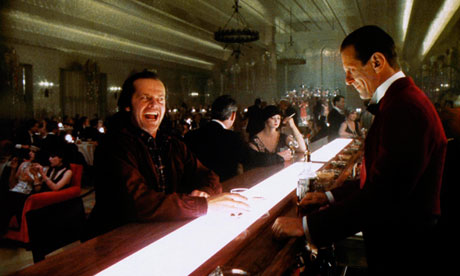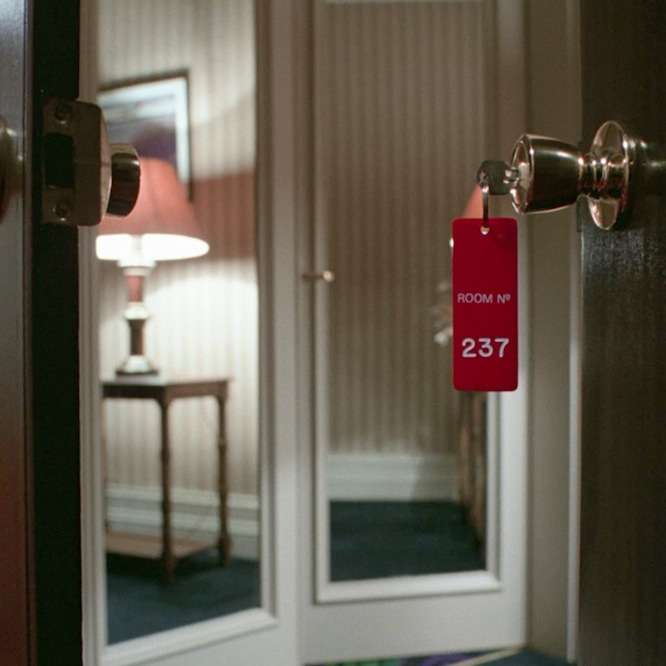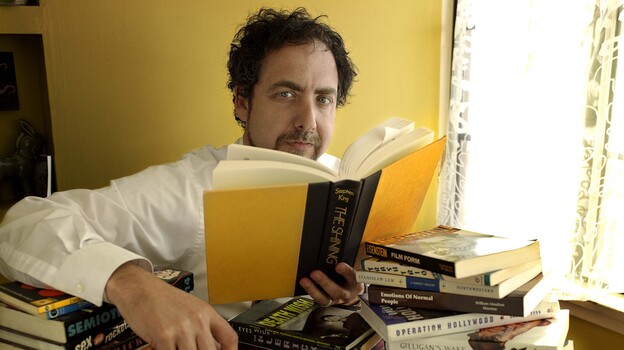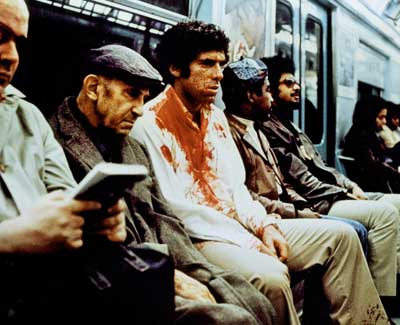

http://www.vulture.com/2013/03/the-shin ... -maze.html
1. It’s Really About the Native American Genocide
Theorist: Bill Blakemore, television correspondent, author.
Theory: The film is about the horrible crimes perpetrated on Native Americans by whites.
Evidence: In the movie (but not the Stephen King novel on which it was based), the Overlook Hotel is said to be built on a Native American graveyard. There are Native American artifacts and designs throughout the hotel (1); the hotel’s pantry, which figures in important scenes, is well stocked with Calumet baking powder (2), whose labels prominently feature an American Indian. (Calumet means “peace pipe,” and the cans symbolize the broken peace pipe, both between white men and natives and between Jack and his family.) Blakemore posits that The Shining suggests we can only escape this “nightmare of history” by retracing our steps—just as Danny Torrance does in the hedge maze.
2. It’s Really About the Nazi Holocaust
Theorist: Geoffrey Cocks, professor of history, Albion College, Michigan.
Theory: The film is an allegory about coming to terms with Hitler’s extermination camps.
Evidence: Jack Torrance’s Adler typewriter (1) is manufactured in Germany: “a bureaucratic killing machine,” Cocks said in one interview. The number 42 is on Danny’s sweatshirt (2); Wendy Torrance swings the bat 42 times at her husband; 1942 was the year of the Final Solution, and 42 has been used as shorthand to refer to the Holocaust. The film has abundant eagle imagery, symbolizing state power. After Danny has his first vision of the elevators gushing blood, a sticker of Dopey the Dwarf (3) on his bedroom door disappears: “Before,” Cocks says, “Danny had no idea about the world. And now, he knows. He’s no longer a dope about things.” Kubrick was indeed researching a proposed Holocaust film around this time.
3. It’s Really About the Minotaur in His Maze
Theorist: Juli Kearns, playwright, novelist.
Theory: The film is based on the Greek myth of the Cretan half-bull, half-man at the center of a labyrinth, slain by Theseus.
Evidence: The hedge maze (1); the labyrinthine architecture of the hotel (2); the “impossible window” (3) in the office of Jack Torrance’s boss; several images of the Minotaur, notably the Monarch skiing poster (4) on the wall in the game room.
4. It’s Really About the Faked Apollo Moon Landing
Theorist: Jay Weidner, author, filmmaker, independent scholar.
Theory: Weidner and others believe that the moon landing witnessed on television was faked, created on a soundstage by Stanley Kubrick in collusion with the U.S. government; Weidner believes that the film is Kubrick’s attempt to come to terms with his supposed involvement.
Evidence: Danny wears an Apollo 11 sweater (1); Room 237 (2) represents the moon-landing stage where Kubrick supposedly worked—the moon is about 237,000 miles from Earth; the prevalence of Tang cans (3) (created for astronauts) in the hotel’s pantry; the pattern on the carpet (4) where Danny plays matches that of Launch Pad 39A, from which the Apollo rocket took off.
http://deadspin.com/room-237-will-make- ... -459090667
One of the saddest things about the death of a favorite filmmaker is realizing that you'll probably never see any new movie from him ever again. When popular musicians die, they always leave material lying around that their estates can spruce up and put out for the fans. (Jimi Hendrix died in 1970, and he's still releasing albums.) But when Stanley Kubrick died in March 1999, he had essentially finished his final film, Eyes Wide Shut, and his many fans knew that that there would never be another Kubrick movie ever again. You could watch his existing movies over and over again, but there would never be another chance to get enraptured and surprised by a new Kubrick work. Fourteen years after his death, I still miss the guy–and I really miss that excitement for a new Kubrick movie.
Maybe that's in part why I love Room 237 so much. Directed by Rodney Ascher, the documentary (which opens on Friday in New York and will be available on-demand) compiles some of the most popular theories about the hidden meanings within Kubrick's 1980 horror movie The Shining, based on Stephen King's book. Ascher and his interview subjects haven't uncovered a new Kubrick film, but they've done the next best thing: They've given his fans a chance to revisit a classic with fresh eyes. It's a decent consolation prize.
The people who speak in Room 237 have been sounding off about their alternate readings of The Shining for more than two decades, so Kubrick obsessives won't necessarily be surprised by the theories collected in the documentary. But by bringing these individuals together in one film–and offering little indication of which theories he personally finds more or less persuasive–Ascher has created a rich tapestry of ideas that, collectively, recalibrate your thinking about a movie that you've probably seen several times over your life. I don't necessarily buy that Kubrick intended any of these alternate readings, but the passion these people bring to their theories is such that you're at least willing to meet them halfway. In the process, the brilliance of The Shining reemerges, shaking off your familiarity with the movie.
I don't want to discuss what theories are mentioned in the movie; you should discover them yourself. (They're easy to find online, if you're curious.) But I will say that they encompass everything from mass genocide to government coverups to spatial inconsistencies within the Overlook Hotel, where most of The Shining is set. It's not as if these theorists are all kooks and weirdos: Bill Blakemore, who's been writing about his interpretation of The Shining since the '80s, has been an ABC News reporter for over 35 years. But Ascher's stroke of genius was to not show any of his subjects throughout the documentary. Instead, we get a title card that introduces each of the six people; we merely hear their voices as they explain in a calm, measured fashion why, for instance, the cans of food in the Overlook Hotel are much, much more significant than the rest of us could have possible realized.
Ascher complements his subjects' theories with scenes they're describing–or, for variety, a scene from another Kubrick movie that also ties in. So rather than looking at these people, we're looking at The Shining: sometimes slowed-down, sometimes looped, sometimes in reverse. We're looking and looking and looking at the movie. And no matter how far-fetched the theories become, the sheer conviction of the speakers matched with the arresting images start to take on their own sort of truth. (Also great is Jonathan Snipes and William Hutson's foreboding score with its through-the-looking-glass spookiness and urgency.)
Room 237 is really just the latest example of remix culture, one artist building off the work of another to create something that readjusts how we feel about the original work. In popular culture, that happens most noticeably in viral mashups–think Trent Reznor and Carly Rae Jepsen smashed together or the Toy Story 3: Inception trailer–that are clever but also sort of disposable. (You think about them for a second, and then you click on another "Harlem Shake" video.) There have, however, been larger, more ambitious film projects along these same lines, such as Rebirth of a Nation (where DJ Spooky "remixed" Birth of a Nation) and The Clock (Christian Marclay's engrossing video that consists of existing movie and TV scenes that take place chronologically over a 24-hour period). Beyond simply being clever, these projects force you to look at older work in a new light. In The Clock, for instance, you're constantly aware how time is always a factor when telling a story, and how you yourself are spending time when you watch a film. By comparison, Room 237 is something of a happy middle ground between the silly, shallow pleasures of viral mashups and the more intellectual pursuits of The Clock, which you can only see at a museum and only at certain times. Room 237 is a documentary that cuts open and examines a horror favorite, but along the way it asks lots of thoughtful questions about how we interpret movies and how a director's intention and an audience's takeaway can be very, very different.
Room 237 is also just really fun. For all its obsessive talk and odd theories, it's really about a deep love for The Shining and and its filmmaker. And in the end, that's what I respond to the most. I've seen it twice now, and both time it's made me want to watch The Shining immediately. That's weird because, really, I'd been watching it for the 100 minutes or so that the documentary was on. But Room 237 draws you in and screws with your head so much that, when it's over, you feel like you need to see the original source again to make sure that what you thought the movie was about really is accurate. (I've also seen it as a dark satire on the traditional American family.) In its own way, the documentary is as frightening as the movie it's analyzing. You get lost in Room 237, and although it can be really funny–some of the theories are just plain nuts–you start to get disoriented, with only these disembodied voices leading you through the Overlook. There will never be another Stanley Kubrick film, but Room 237 so expertly rewires your feelings about The Shining that a 33-year-old movie suddenly feels brand new.










